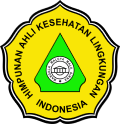FAKTOR LINGKUNGAN YANG BERHUBUNGAN DENGAN DIARE PADA ANAK BALITA DI DESA HAJIMENA KECAMATAN NATAR KABUPATEN LAMPUNG SELATAN TAHUN 2019
DOI:
https://doi.org/10.26630/rj.v15i2.2788Keywords:
Diarrhea, toddlers, environment, wasteAbstract
The diarrhea morbidity rate in the working area of the Hajimena Health Center tends to increase from year to year. During the last two years, the highest incidence of diarrheal disease was in the 1-4 year age group. This study aims to determine the relationship between environmental factors and the incidence of diarrhea in children under five. This study used a cross-sectional design. The research population was all children under five (1-5 years) in Hajimena Village, South Lampung Regency, 1,052 people. The sample in this study was 101 toddlers who were selected randomly—collecting data by observation and interviews. Data analysis was carried out univariate and bivariate using the Chi-Square test. The results of this study indicate a significant relationship between diarrhea in children under five with waste disposal facilities (p-value = 0.010) and waste water disposal facilities (p-value = 0.001). Meanwhile, clean water facilities and family latrine facilities, in this study, did not show a significant relationship. Increased knowledge and skills of the community in managing household waste is needed in an effort to reduce the incidence of diarrhea in children under five.Â
References
Adisasmito, W. (2007). Faktor Risiko Diare pada Bayi dan Balita di Indonesia. Jurnal Makara Kesehatan, 11(1), 1–10.
Ahyanti, M., Rosita, Y., & Yushananta, P. (2020). Utilisation of the family latrine post declaration ODF. International Journal of Innovation, Creativity and Change, 13(2), 192–204.
Boyd, A. T., Cookson, S. T., Anderson, M., Bilukha, O. O., Brennan, M., Handzel, T., … Gerber, M. (2017). Centers for Disease Control and Prevention Public Health Response to Humanitarian Emergencies, 2007–2016. Centers for Disease Control and Prevention, Emerging Infectious Diseases, 23(12).
Dinas Kesehatan Kabupaten Lampung Selatan. (2017). Profil Kesehatan Kabupaten Lampung Selatan. Kalianda: Dinas Kesehatan Kabupaten Lampung Selatan.
Hariani, & Ramlah. (2019). Pelaksanaan Program Penanggulangan Diare di Puskesmas Matakali. Jurnal Kesehatan Masyarakat, 5(1), 34–46. https://doi.org/http://dx.doi.org/10.35329/jkesmas.v5i1.307
Hasanah, A. U., Buety, A., & Iswadi. (2014). Desain Model Sumur Resapan Untuk Pengolahan Limbah Cair Rumah Tangga. Jurnal Fiska Dan Terapan, 1, 1–11. https://doi.org/https://doi.org/10.24252/jft.v1i1.15737
Ikhwan, Z. (2013). Faktor Individu Dan Keadaan Saluran Pembuangan Air Limbah (SPAL) Rumah Tangga Dengan Kejadian Diare Di Rt 01 Rw 09 Kelurahan. 4(2), 416–419. https://doi.org/http://dx.doi.org/10.26630/jk.v4i2.86
Imada, K. S., de Araújo, T. S., Muniz, P. T., & de Pádua, V. L. (2016). Socioeconomic, hygienic, and sanitation factors in reducing diarrhea in the Amazon. Revista de Saude Publica, 50, 1–10. https://doi.org/10.1590/S1518-8787.2016050006505
Kementerian Kesehatan RI. (2014a). Buku Pedoman Pengendalian Penyakit Diare. Jakarta: Ditjen Pengendalian Penyakit dan Penyesahatan Lingkungan.
Kementerian Kesehatan RI. Peraturan Menteri Kesehaan Republik Indonesia No. 3 Tahun 2014 Tentang Sanitasi Total berbasis Masyarakat. , (2014).
Kementerian Kesehatan RI. (2020). Profil Kesehatan Indonesia Tahun 2019. In Short Textbook of Preventive and Social Medicine. https://doi.org/10.5005/jp/books/11257_5
Kirana, N. (2016). Hubungan antara faktor presdisposisi pada ibu terhadap kejadian diare pada balita. Jurnal Promkes, 6(1), 70–79.
Mar’atusholikhah, M. (2019). Perilaku Hidup Bersih dan Sehat sebagai Bentuk Pencegahan Diare Akut di PP Jamilurrahman Bantul. (2005). https://doi.org/10.31227/osf.io/xgcrp
Monica, D. Z., Ahyanti, M., & Prianto, N. (2020). Hubungan Penerapan 5 Pilar Sanitasi Total Berbasis Masyarakat (STBM) Dan Kejadian Diare Di Desa Taman Baru Kecamatan Penengahan Kabupaten Lampung Selatan. Ruwa Jurai: Jurnal Kesehatan Lingkungan, 14(2), 71–77. https://doi.org/10.26630/rj.v14i2.2183
Pickering, A. J., Ercumen, A., Arnold, B. F., Kwong, L. H., Parvez, S. M., Alam, M., … Luby, S. P. (2018). Fecal Indicator Bacteria along Multiple Environmental Transmission Pathways (Water, Hands, Food, Soil, Flies) and Subsequent Child Diarrhea in Rural Bangladesh [Research-article]. Environmental Science & Technology, 52(14), 7928–7936. https://doi.org/10.1021/acs.est.8b00928
Pudjaningrum, P., Wahyuningsih, N. E., & Darundiati, Y. H. (2016). Pengaruh Metode Pemicuan Terhadap Perubahan Perilaku Masyarakat Buang Air Besar Sembarangan pada Masyarakat Kelurahan Kauman Kidul Kota Salatiga. Jurnal Kesehatan Masyarakatsyarakat, 4(5), 100–108.
Purnama, S. G. (2016). Modul pengolahan sampah organik rumah tangga. Denpasar: Departemen Kesehatan Lingkungan Prodi Kesehatan Masyarakat.
Puskesmas Hajimena. (2018). Profil Puskesmas Hajimena Tahun 2017. Hajimena, Lampung Selatan: Puskesmas Hajimena.
Putra, A. D. P., Rahardjo, M., & Joko, T. (2015). Hubungan Sanitasi Dasar Dan Personal Hygiene Dengan Kejadian Diare Pada Balita Di Wilayah Kerja Puskesmas Tasikmadu Kabupaten Karanganyar. Universitas Diponegoro, Semarang.
Rahim, Z. H. A., Pinontoan, O. R., & Wilar, R. (2016). Hubungan anatara Fasilitas Sanitasi Dasar dan Personal Hygiene dengan Kejadian Diare pada Balita di Wilayah Kerja Puskesmas banggai Kabupaten Banggai Laut. Universitas Samratulangi, Manado.
Rohmah, S. (2019). Pengaruh Paparan, Lingkungan, Tokoh Masyarakat, dan Tenaga Kesehatan terhadap Partisipasai dalam Desa Siaga. Jurnal Kesehatan Bakti Tunas Husada: Jurnal Ilmu-Ilmu Keperawatan, Analis Kesehatan Dan Farmasi, 19(1), Hal. 133-149. https://doi.org/10.36465/jkbth.v19i1.460
Rosita, Y., Ahyanti, M., & Yushananta, P. (2021). Model Pemberdayaan Masyarakat Menuju Desa ODF (1st ed.; M. B. Muvid, Ed.). Surabaya: CV. Global Aksara Pres.
Sanyaolu, A., Okorie, C., Marinkovic, A., Jaferi, U., & Prakash, S. (2020). Global Epidemiology and Management of Acute Diarrhea in Children from Developing Countries. Ann Pediatr Child Health, 8(8), 1205.
Selviana, W. W. (2015). Terjadinya Penyakit Diare Akut pada Balita di Wilayah Pesisir. Universitas Muhammadiyah Pontianak.
Setiyono, A. (2019). Faktor Risiko Kejadian Diare pada Masyarakat Kota Tasikmalaya. Jurnal Kesehatan Komunitas Indonesia, 15(2), 49–59.
Setyowati, R., & Mulasari, S. A. (2013). Pengetahuan dan Perilaku Ibu Rumah Tangga dalam Pengelolaan Sampah Plastik. Kesmas: National Public Health Journal, 7(12), 562. https://doi.org/10.21109/kesmas.v7i12.331
Sukma, H., Mursid, & Nurjazuli. (2018). Hubungan Pengetahuan, Sikap Bab, Dan Kepemilikan Septic Tank Dengan Status Odf (Open Defecation Free) Di Kecamatan Candisari Kota Semarang. Jurnal Kesehatan Masyarakat (e-Journal), 6(6), 143–149.
Syam, S., & Asriani, A. (2019). Penerapan Sanitasi Total Berbasis Masyarakat (Stbm) Pilar 1 Stop Buang Air Besar Sembarangan (Stop Babs) Dengan Kejadian Penyakit Diare Di Kelurahan Lakkang Kecamatan Tallo Kota Makassar. Sulolipu: Media Komunikasi Sivitas Akademika Dan Masyarakat, 19(1), 109. https://doi.org/10.32382/sulolipu.v19i1.1035
Ugboko, H. U., Nwinyi, O. C., Oranusi, S. U., & Oyewale, J. O. (2020). Childhood diarrhoeal diseases in developing countries. Heliyon, 6(4), e03690. https://doi.org/10.1016/j.heliyon.2020.e03690
UNICEF. (2020). Diarrhoea. Retrieved from UNICEF website: https://data.unicef.org/topic/child-health/diarrhoeal-disease/
Wibisono, A. M., Marchianti, A. C. N., & Dharmawan, D. K. (2020). Analisis Faktor Risiko Kejadian Diare Berulang Pada Balita Di Puskesmas Sumberjambe Kabupaten Jember. Journal of Agromedicine and Medical Sciences, 6(1), 43–52.
Yuliasri, T. R., & Astuti, P. P. S. (2016). Pengaruh Penyuluhan Kesehatan terhadap Pengetahuan Ibu Tentang Penanganan Balita Diare Di Rumah. Jurnal Ilmu Kebidanan, 3(2), Hal. 145-152.
Yushananta, P., Ahyanti, M., & Hasan, A. (2018). Community Based Total Sanitation in Muara Putih Village, Natar District, Pesawaran Regency. Sakai Sambayan: Journal of of Community Service, 2(2), 76. https://doi.org/10.23960/jss.v2i2.79
Yushananta, P., & Bakri, S. (2021). Analisis Pembiayaan Peningkatan Akses Air Minum dan Sanitasi Sehat Dengan Pendekatan Cost Benefit Analysis (CBA). Jurnal Kesehatan, 12(2), 306. https://doi.org/10.26630/jk.v12i2.1855
Yushananta, P., & Usman, S. (2018). The Incidence of Diarrhea in Babies Affected through the Cleanliness of Eating Utensils and Hands. Journal of Medical Science And Clinical Research, 6(9). https://doi.org/10.18535/jmscr/v6i9.137
Zicof, E., & Idriani, E. (2020). Faktor Risiko Kejadian Diare Pada Balita Di Kota Padang. Jurnal Bidang Ilmu Kesehatan, 10(2), 169–182. https://doi.org/10.52643/jbik.v10i2.1097
Downloads
Published
How to Cite
Issue
Section
License
Copyright (c) 2021 Ruwa Jurai: Jurnal Kesehatan Lingkungan

This work is licensed under a Creative Commons Attribution-NonCommercial 4.0 International License.

Ruwa Jurai: Jurnal Kesehatan Lingkungan is licensed under a Creative Commons Attribution-NonCommercial 4.0 International License.
Authors who publish with this journal agree to the following terms:
- Authors retain copyright and grant the journal right of first publication with the work simultaneously licensed under a Creative Commons Attribution-Non Commercial License that allows others to share the work with an acknowledgment of the work's authorship and initial publication in this journal.
- Authors are able to enter into separate, additional contractual arrangements for the non-exclusive distribution of the journal's published version of the work (e.g., post it to an institutional repository or publish it in a book), with an acknowledgment of its initial publication in this journal.
- Authors are permitted and encouraged to post their work online (e.g., in institutional repositories or on their website) prior to and during the submission process, as it can lead to productive exchanges, as well as earlier and greater citation of published work.









